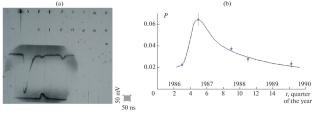在密歇根州立大学扩展风淋阵中寻找延迟粒子登记频率的变化
IF 0.48
Q4 Physics and Astronomy
Bulletin of the Russian Academy of Sciences: Physics
Pub Date : 2025-07-15
DOI:10.1134/S1062873825711365
引用次数: 0
摘要
利用莫斯科国立大学(MSU)的广泛风淋阵(EAS)阵列研究了能量大于1014 eV的广泛风淋阵(EASes)中粒子的时间分布。延迟粒子在所有ease中约占3.5%。讨论了1986年至1990年观测到的闪光频率,并在1987年达到最大值。闪衰的精细结构由一系列周期为~ 4天和持续时间为~ 32.5天的准周期阻尼振荡爆发组成。EAS注册频率在统计误差范围内没有变化。本文章由计算机程序翻译,如有差异,请以英文原文为准。

Search for Variations in the Frequency of Registering Delayed Particles at the MSU Extensive Air Shower Array
The Moscow State University (MSU) Extensive Air Shower (EAS) array is used to study the temporal distributions of particles in extensive air showers (EASes) with energies greater than 1014 eV. Delayed particles are registered in ~3.5% of all EASes. The flash observed in the frequency of their registration from 1986 to 1990 with a maximum in 1987 is discussed. The fine structure of flash decay consists of a series of bursts of quasi-periodic damped oscillations with periods of ∼4 days and durations of ∼32.5 days. The frequency of EAS registration does not change within the limits of statistical error.
求助全文
通过发布文献求助,成功后即可免费获取论文全文。
去求助
来源期刊

Bulletin of the Russian Academy of Sciences: Physics
Physics and Astronomy-Physics and Astronomy (all)
CiteScore
0.90
自引率
0.00%
发文量
251
期刊介绍:
Bulletin of the Russian Academy of Sciences: Physics is an international peer reviewed journal published with the participation of the Russian Academy of Sciences. It presents full-text articles (regular, letters to the editor, reviews) with the most recent results in miscellaneous fields of physics and astronomy: nuclear physics, cosmic rays, condensed matter physics, plasma physics, optics and photonics, nanotechnologies, solar and astrophysics, physical applications in material sciences, life sciences, etc. Bulletin of the Russian Academy of Sciences: Physics focuses on the most relevant multidisciplinary topics in natural sciences, both fundamental and applied. Manuscripts can be submitted in Russian and English languages and are subject to peer review. Accepted articles are usually combined in thematic issues on certain topics according to the journal editorial policy. Authors featured in the journal represent renowned scientific laboratories and institutes from different countries, including large international collaborations. There are globally recognized researchers among the authors: Nobel laureates and recipients of other awards, and members of national academies of sciences and international scientific societies.
 求助内容:
求助内容: 应助结果提醒方式:
应助结果提醒方式:


